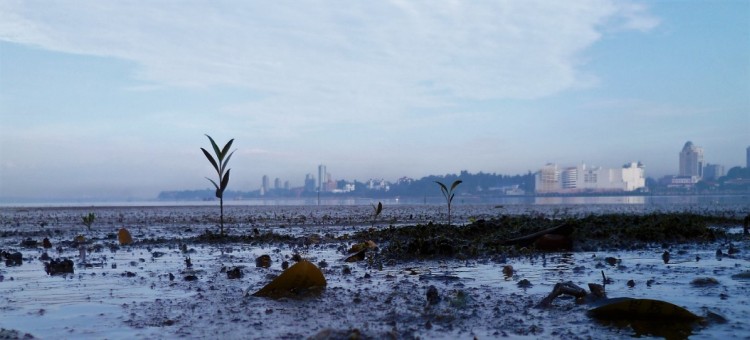M. Gelderland1*, E.M. Horstman1, P.W.J.M. Willemsen1,2,3, D.A. Friess4, J.B. Alemu4, E.S. Yando4,
K.M. Wijnberg1
1 University of Twente,
Introduction
Mangrove forests are well known as coastal ecosystem defences. Mangrove trees have a significant role in these systems as they attenuate hydrodynamic forces and contribute to the reduction of coastal erosion, (Horstman et al., 2014). However, a mechanistic understanding of the feedbacks of hydro- and morphodynamic stresses on mangrove seedling survival is lacking for the period after establishment (Balke et al., 2011). These feedbacks are key for the development and resilience of mangroves, particularly in an urban area where stressors such as limited accommodation space and reduced sediment supply are prevalent. In this work we address the effects of waves and tidal currents, including fluctuations therein over a seasonal timescale, on the morphodynamics and their combined impact on mangrove seedling development.
Methods
Our study site is a narrow mangrove fringe (~30 m wide) in front of a stop bank in the Sungei Buloh Wetland Reserve (northern coast of Singapore). Along a cross-shore transect, we deployed two frames with Echologgers, to monitor high-resolution surface elevation changes, wave gauges and current meters. The monitoring period comprised a three month period. Seedling numbers, heights, diameters and leave counts are monitored for 10 plots of 1 m2 for the same period. Furthermore, sediment properties and representative vegetation tree data is collected.
Preliminary results
Preliminary results show a decreasing number of mangrove seedlings within the monitored plots. The average diameter, height and number of leaves show a more stable result, but slightly increase as the largest seedlings survive. The number of pneumatophores (i.e. aboveground pencil roots) varies increases from O(101) at the stop bank to O(102) at the front of the forest. Tidal inundation of the study site exceeds 2 m during spring tides, but reduces to less than 0.5 m during neap tides. Observed significant wave heights are relatively low O(10-1) m due to the small fetch in the narrow straits fronting the study site. Across this narrow fringe, waves are attenuated for approximately 13% per 10 meter. Observed bed level changes show very limited erosion and deposition rates of O(10-2) m. This is in line with the limited wave activity and dense near-bed root cover. Preliminary results indicate that the decrease in seedling numbers is related with an increase of the wave energy. This and other stresses will be further quantified to identify potential correlations in the temporal changes of seedling survival, hydro- and morphodynamics.

Figure 1 Avicennia seedlings establishing in the mangroves fringing the north shore of Singapore.
References
Balke, T. et al. (2011). Windows of opportunity : thresholds to mangrove seedling establishment on tidal flats, 440, 1–9.
Horstman, E. M. et al. (2014). Wave attenuation in mangroves: A quantitative approach to field observations. Coastal Engineering, 94, 47–62.
I. Surname1*, F.N. Another-Surname2 , Y. Next-Surname2
1 University Name, Country; 2 Organization Name, Country
* Corresponding author: mail.name@organization.org


